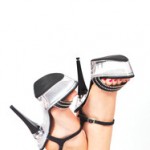The funny thing about sitting with your eyes at street level is what you notice first. The other day I had some time before court and was sitting at a local DC pastry shop. The shop is on a slight hill, and most of it is below grade. As a result, the first thing I see out its window are shoes and pants cuffs. I decided to play, “make-up-a-stranger’s-life-story” based on what I could see. Ask any writer and I suspect he’ll tell you that he plays a version of “make-up-a-stranger’s-life-story” every time he goes out. It’s one of the ways that I come up with character descriptions.
While playing the game using shoes and the edges of pants, I realized how often quick assumptions were accurate. The shoes often did predict the rest of the outfit. A pair of scuffed, mud-splattered work boots pushed a rolling cart up the hill. Frayed light blue jeans hid the boot tops from view. When their owner made it further up the hill, I wasn’t surprised to see a gray-haired stoop shouldered man behind the cart. His face was as creased and lined as his faded blue jeans. The pair of trendy black and white sneakers over pristine blue jeans, on the other hand, belonged to a 20-something student or tourist.
When we create a character we have to visualize everything about him. Our readers need to see the entire character. Outfits matter. Despite the popularization of an unsustainable media image, a warrior princess shouldn’t be in three inch heels. The successful business man shouldn’t be wearing grubby sneakers on his way to work. As writers we can add depth to our characters by upsetting common stereotypes- no, not the racial profiling ones, the ones like a lawyer always should be in a suit and tie.
Writers vary in how much detail they write down in advance about their characters. Some of us do detailed character bios and interviews. Numerous software programs create mechanisms for us to record the information. You might not consciously think about what shoes your character is likely to wear, but your readers will know if you got it wrong. If you deviate from expectations – say, lawyers wear suits and dress shoes to court- you need a reason your readers will accept for the deviation. The scene in My Cousin Vinnie where Vinnie shows up in Court in a purple prom tux is great because the outfit is so ludicrous. It provides additional humor. The audience accepts the sight gag because we know his suit’s been destroyed and Vinnie explains what he had to do to find something not completely objectionable for court that day.
In creating character, shoes are one of those little details that matter. It’s not enough to know that your main character wears sneakers. You need to know whether the laces still have their aglets. Does he tie his shoes or are people always telling him to do so? Will those details make it into your story? Maybe. The fact that your character is always stopping to tie his shoes might be a plot device or character trait that lends depth and reality to your story.
As a writing experiment, go someplace where your vision is restricted like the basement pastry shop I was in before court. Puzzle out the rest of the outfit from on that first limited view of the person. Once you have an outfit, flesh out why your character chose those clothes that morning. Is she out sightseeing? Is she in uniform? Is she taking her son to the playground? Now, what in her life brought her to the moment you saw her? What happens next?
Writers get inspiration from all sorts of places. Sometimes even a fabulous pair of shoes.


